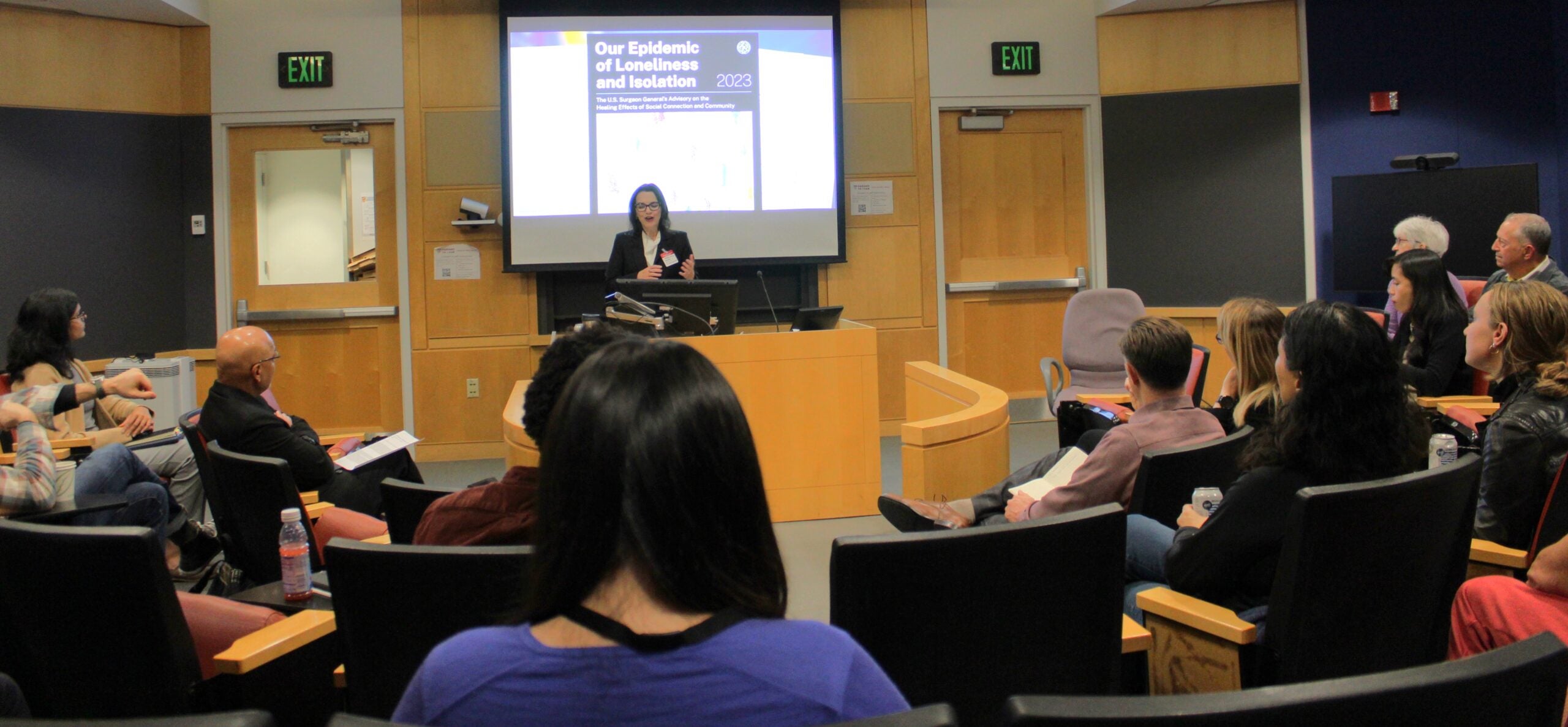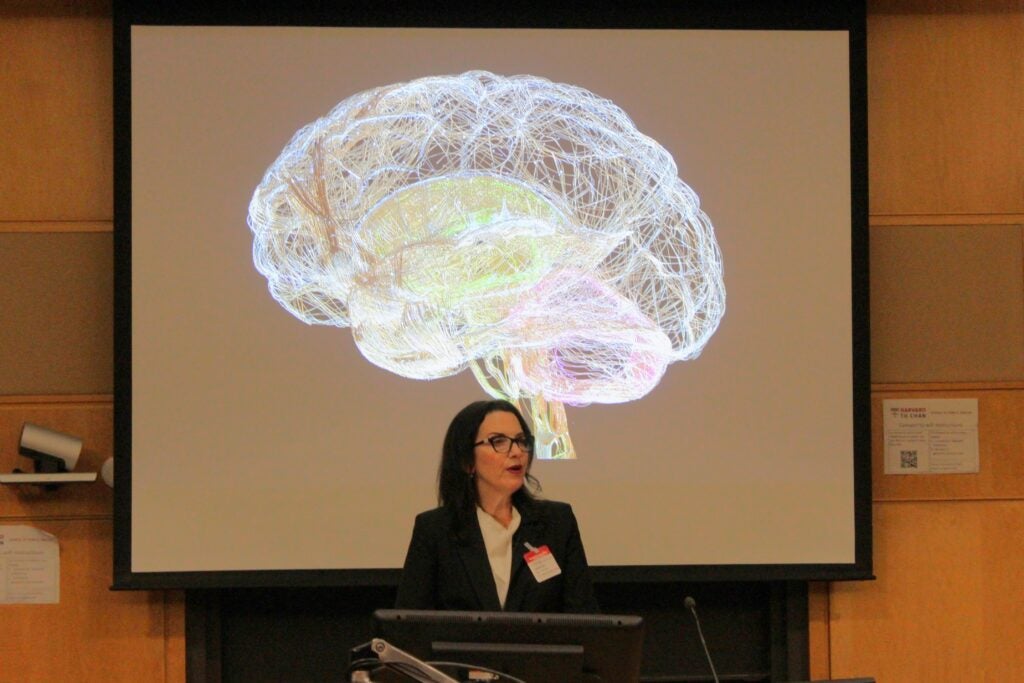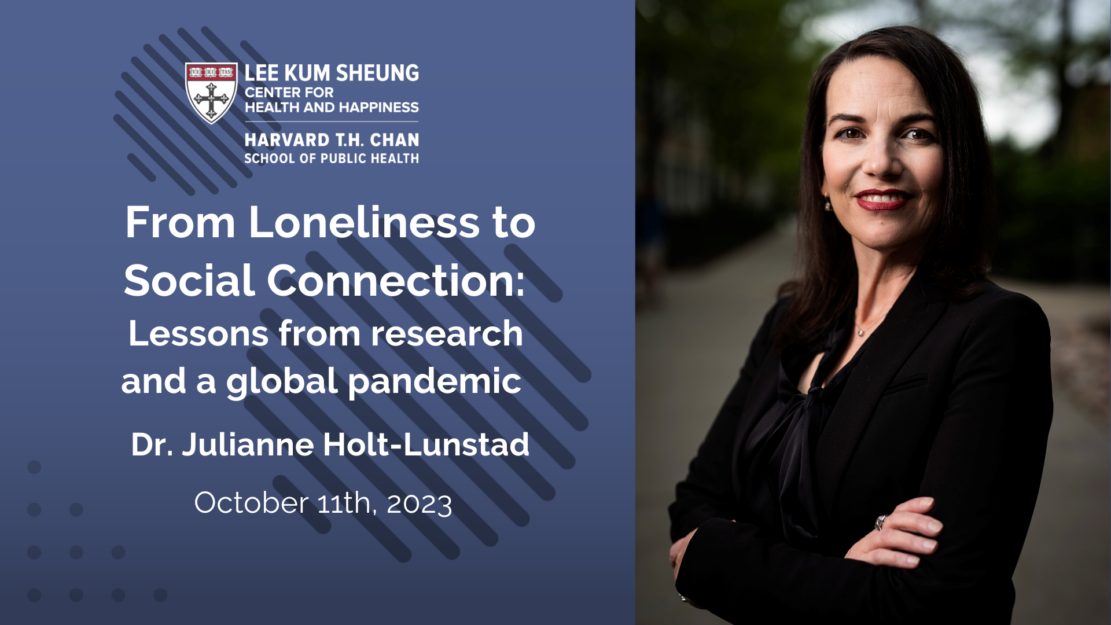Even prior to the Covid-19 pandemic, roughly half of American adults reported experiencing loneliness, according to U.S. Surgeon General Vivek Murthy. Published last May, “Our Epidemic of Loneliness and Isolation: The U.S. Surgeon General’s Advisory on the Healing Effects of Social Connection and Community” addresses the serious public health threat represented by loneliness in the US. Dr. Julianne Holt-Lunstad, Lead Scientific Editor of the Advisory, visited Harvard on October 11th to share her insights into this critical issue. Her presentation, “From Loneliness to Social Connection: Lessons from Research and a Global Pandemic”, was the first event in the Center’s Loneliness and Well-being Seminar Series.
The Problem: Loneliness and Social Isolation

“The Advisory, my own work, and decades of interdisciplinary research are based on the premise that humans are fundamentally a social species,” stated Dr. Holt-Lunstad. She explained that the human need to be social is a part of our neurobiology, which can shape how we think, feel, and behave. When our social needs aren’t met for a sustained period, the resulting dysregulation of our biological systems can lead to the development of disease. Negative effects of social isolation include increased risk for heart attack, stroke, and type 2 diabetes, increased risk for depression, anxiety, addiction, and suicide, and increased risk for dementia and Alzheimer’s.
- Loneliness: The unpleasant subjective perception arising from the discrepancy between an individual’s desired and actual level of social connection.
- Social Isolation: A state in which an individual has objectively few social relationships or roles, and infrequent social contact
In 2015, Dr. Holt-Lunstad, in collaboration with other researchers, conducted a comprehensive meta-analysis which gathered and synthesized all available global data at the time—including over 3.4 million participants—to examine the association between loneliness, social isolation, and mortality risk. The findings from this study revealed that among initially healthy people followed over time, loneliness was associated with a 26% increase in the risk of premature death, social isolation with a 29% increase, and living alone with a staggering 32% escalation in mortality risk.
The US Surgeon General’s Advisory posits that the mortality impact of lacking social connection is akin to that of smoking up to 15 cigarettes per day, surpassing even the risks associated with obesity and physical inactivity.
Moreover, loneliness and social isolation exert far-reaching repercussions on economic as well as academic outcomes. A lack of social contacts among older adults is associated with an estimated $6.7 billion in additional Medicare spending annually. However, the economic impact of loneliness is probably even more substantial, as it is also connected to increased absenteeism, reduced productivity, and lower work quality. Similarly, the absence of social connections hinders students’ advancement, even in higher education settings. This deficiency of social connections is frequently cited as a leading reason why students drop out of educational programs.
The Solution: Social Connection
 Studies show that on average, people who have strong social connections are happier, healthier, and live longer than those who don’t. In 2010, Dr. Holt-Lunstad and colleagues reviewed 148 studies examining the protective effect of being socially connected and found that social connection increases odds of survival by 50%.
Studies show that on average, people who have strong social connections are happier, healthier, and live longer than those who don’t. In 2010, Dr. Holt-Lunstad and colleagues reviewed 148 studies examining the protective effect of being socially connected and found that social connection increases odds of survival by 50%.
The advantages of social connection go beyond individual well-being to have a positive impact on society as a whole. These benefits include improved public health, community safety, resilience, economic prosperity, and the functioning of representative government.
Social connection can be especially important in times of crisis. “The ability to mobilize resources via one’s social connections can be a matter of survival,” emphasized Dr. Holt-Lunstad. “As extreme weather patterns become more frequent, connected communities will be crucial to weathering these environmental crises.”
Dr. Holt-Lunstad went on to argue that social isolation is more than just a personal issue, mentioning an array of factors that can significantly impact our level of social connectedness. These factors can encompass personal elements like individual health and financial stress, as well as the nature of one’s interactions within their home environment, which may either provide support or create strain.
Additionally, the safety and accessibility of our neighborhoods, as well as the availability of communal spaces, are all factors that can affect our social connections. Each of these factors can not only underlie potential causes of isolation or loneliness but can also serve as a potential avenue for solutions. Dr. Holt-Lunstad contended that addressing the problem of social isolation requires change across all levels of society.
What Can Be Done?

Dr. Holt-Lunstad has conducted extensive research into methods for promoting social connection. One such research project was a randomized controlled trial run in 2021, which tested the effects of an intervention to foster social connection. The intervention included approximately 4,500 participants in the US, the UK, and Australia. Half of the participants were randomly assigned to a “Kind Challenge”, while the others were designated as a control group. The group that received the Kind Challenge were asked to do small acts of kindness for their neighbors. “The results were striking,” said Dr. Holt-Lunstad. “Acts of kindness significantly reduced loneliness, stress, and conflict with neighbors.”
To move beyond an individualistic or health sector perspective and foster a whole-of-society approach, Dr. Holt-Lunstad and her colleagues developed the “SOCIAL Framework,” which stands for the “Systemic Framework Of Cross-sector Integration and Action across the Lifespan.” This framework is designed to illustrate the intersectionality of various factors impacting health. At its core, it features two main axes: one that delineates the influence across the socio-ecological model (encompassing individual, interpersonal, institutional/organizational, community, and society levels), and another that encompasses selected sectors from WHO’s Health in All Policy framework (HiAP). These sectors include clinical and population health, transportation, housing, employment, nutrition, environment and sanitation, education, and leisure. The framework is intentionally flexible, dynamic, and crafted to build upon and enhance previous models significantly. For example, it explicitly incorporates a lifespan approach at each intersection between socioecological levels and sectors, representing a notable improvement over earlier models.
By focusing on the intersections between these factors, policymakers, public health professionals, community groups, or any number of other parties can identify, test, and evaluate potential solutions to loneliness and social isolation. For example, a policymaker could look at the intersection between an institutional level of impact, the education sector, and lifespan, with a focus on childhood, to arrive at the idea to introduce the topic of social connection into school curriculums. Or a community group could look at the intersection between an individual level of impact, the transportation sector, and lifespan (older age), and come up with an intervention which provided discounted ridesharing transportation for older adults, helping participants get to their medical appointments.
While formal programs and policies can have a substantial impact, explained Dr. Holt-Lunstad, the informal behaviors of our daily lives, and the norms and cultures of our society, also play a crucial role in shaping social connections. A culture that fosters connection is built on fundamental values such as kindness, respect, service, and commitment to one another.
“Although this is not a new issue, the pandemic brought increased awareness and urgency to the importance of social connection,” concluded Dr. Holt-Lunstad. “It highlighted the need to apply the most rigorous science available to address real-world problems, and the need to communicate this effectively to the public. This is a critical opportunity to catalyze this shared experience to coordinate and accelerate efforts to promote social connection in our society.”
Resources
- Our Epidemic of Loneliness and Isolation: The US Surgeon General’s Advisory on the Healing Effects of Social Connection and Community
- Social Isolation and Loneliness in Older Adults: Opportunities for the Health Care System
- Loneliness and social isolation as risk factors for mortality: a meta-analytic review
- Social Relationships and Mortality Risk: A Meta-analytic Review
- Advancing Social Connection as a Public Health Priority in the United States
- Social Connection as a Public Health Issue: The Evidence and a Systemic Framework for Prioritizing the “Social” in Social Determinants of Health
- Why Social Relationships Are Important for Physical Health: A Systems Approach to Understanding and Modifying Risk and Protection
Article written by Ayla Fudala, Center Communications Coordinator


You must be logged in to post a comment.